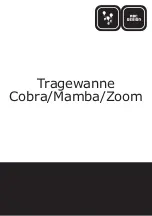
Section AIS‐RM3‐20B
030‐101806 Rev. A
R
1310IBRA
3
Figure 4. RS‐232 Cable's Connector Pin‐out
Pin 1: Data Carrier Detect
Pin 6: Data Set Ready
Pin 2: Receive Data
Pin 7: Request to Send
Pin 3: Transmit Data
Pin 8: Clear to Send
Pin 4: Data Terminal Ready
Pin 9: Ring Indicator
Pin 5: Signal Ground
Mates with
connector on
AISG‐RM3
controller
front panel
Mates with
connector on
computer
RS232 Female pin‐out to Mini Din Male pin‐out
into the port holes (16 ga. max.) This connector is labelled “IN
PUT N.C. N.O. COMM GND”.
INPUT = Digital Input
N.C. = Normally Closed
N.O. = Normally Open
COMM = Communication
GND = Ground
2.2.4.1
Digital Input Contacts
The digital input channel is used to interface a potential free
contact, e.g., a relay. It could be a fire alarm sensor, door sensor,
or failure signal from a power supply in a base station site. The
DI can read the digital input channel status and determine its
alarm state. The INPUT and GND pins are used to make a digit
al input connection.
Pin Label
Description
Specification
INPUT
Digital Input Channel
Logical level 0/1.
Max. Input DC +30V, 100mA
GND
Ground of I/O Channels
Ground
Table 2. Digital Input Contacts
The DI alarm settings are configured in the
System Setting
menu.
2.2.4.2
Digital Output Contacts
This module has two relay outputs. The relay outputs are dedic
ated circuits that can be directly connected inline with the
desired control or indicating device.
Connector
Label
Pin Description
Specification
INPUT
Digital Input channel
Logical level 0/1.
Max. input DC
+30V, 100mA
N.C.
Normally Closed relay output
Contact Capacity:
AC 125V / 0.5A
DC 24V / 1A
N.O.
Normally Open relay output
COMM Common
N/A
GND
Ground of I/O channels
Ground
Table 3. Alarm Connector Pin‐outs
2.2.5
Ethernet Port
An Ethernet port labelled “LAN 10/100M” is provided on the
front of the controller.
This port is used to provide access to the
web‐based user interface either by connecting directly to a local
PC or to a router for remote access.
2.2.6
USB Port
A USB port labelled “USB 2.0” on the front of the controller
is reserved for future expansion.
Port Label
Type
Description
AISG
8‐pin
female
3 AISG ports provided, each Standard
AISG 8pin female IEC 601309 bias/
RS485, connects to an antenna line
device (RET or TMA). Each can control up
to 8 daisy‐chained antenna line devices.
RS‐232
9‐pin,
round,
female
1 RS‐232 port, used to connect to serial
port of a PC for console access
INPUT
N.C.
N.O.
COMM
GND
5‐pin
pluggable
Alarm Connector, 5 wire port holes, screw
down type, accepts 16 gauge wire (max.)
LAN 10/100M
RJ45
Used to connect to a PC or a network
USB 2.0
USB 2.0,
female
Not used, reserved for future use.
24V ‐48V
3‐pin
pluggable
Power connector, 3 wire port holes,
screw down type, accepts 16 gauge wire
(max.), used to connect to power source
Table 4. Front Panel Ports and Connectors
2.2.7
Reset Button
A recessed reset button is provided on the front of the control
ler to perform a hard power‐on reset. Press the button
momentarily to restart the AISG‐RM3 controller. Press and
hold the button for approximately 6 seconds to restore network
settings to the factory default.
2.2.8
Power Connector
A 3‐port pluggable power connector is provided on the front of
the controller to power the unit. The input voltage range for the




































